Polyurethane-Based Porous Carbons Suitable for Medical Application
Abstract
:1. Introduction
2. Materials and Methods
2.1. Star-Shaped Polyol Synthesis
2.2. Star-Shaped Polyol Cross-Linking—Obtaining Polyurethane (PUR)
2.3. Carbonization of Polyurethane
2.4. MALDI ToF Analyses
2.5. FTIR-ATR Analyses
2.6. Light Microscopy
- Registering micrographs of PUR foam and carbon foam;
- Determination of the pore cross-section area in ImageJ (it was assumed that the pore cross-sections are circular);
- Calculation of the pore diameters before and after the carbonization process (1) and their mean values (2);
- Determination of the value of the linear contraction of the pore diameter (3).
- d—pore diameter after the carbonization process;
- P—pore transverse area;
- —average value of the measurements;
- n—number of measurements;
- xi—value of a single measurement;
- Sl—linear pore contraction after the carbonization process;
- d0—pore diameter before the carbonization process.
2.7. Scanning Electron Microscopy (SEM)
- Accelerating voltage: 20 kV;
- Working distance: 10 mm;
- Mode: SEI;
- Magnification: 50×, 200×, 2000×.
2.8. Confocal Laser Scanning Microscope
2.9. Computer Microtomography (CMT)
3. Results
3.1. Examination of Linear Pores Shrinkage of Samples after the Carbonization Process Using a Light Microscope
3.2. Examination of the Morphology and Distribution of Pore Sizes Using A Scanning Electron Microscope (SEM)
3.3. Stereometric Analysis of Surfaces with the Use of Confocal Laser Scanning Microscope
3.4. Examination of the Spatial Structure Using Computed Microtomography (CMT)
4. Discussion
5. Conclusions
Author Contributions
Funding
Institutional Review Board Statement
Informed Consent Statement
Data Availability Statement
Conflicts of Interest
References
- Ibrahim, W.; Carr, L.; Cordell, R.; Wilde, M.J.; Salman, D.; Monks, P.S.; Thomas, P.; Brightling, C.E.; Siddiqui, S.; Greening, N.J. Breathomics for the clinician: The use of volatile organic compounds in respiratory diseases. Thorax 2021, 76, 514–521. [Google Scholar] [CrossRef] [PubMed]
- Neerincx, A.H.; Vijverberg, S.J.H.; Bos, L.D.J.; Brinkman, P.; van der Schee, M.P.; de Vries, R.; Sterk, P.J.; Maitland-van der Zee, A.H. Breathomics from exhaled volatile organic compounds in pediatric asthma. Pediatr. Pulmonol. 2017, 52, 1616–1627. [Google Scholar] [CrossRef] [PubMed]
- Barnes, V.M.; Kennedy, A.D.; Panagakos, F.; Devizio, W.; Trivedi, H.M. Global Metabolomic Analysis of Human Saliva and Plasma from Healthy and Diabetic Subjects, with and without Periodontal Disease. PLoS ONE 2014, 9, 105181. [Google Scholar] [CrossRef] [PubMed]
- Davis, M.D.; Fowler, S.J.; Montpetit, A.J. Exhaled breath testing-A tool for the clinician and researcher. Paediatr. Respir. Rev. 2019, 29, 37–41. [Google Scholar] [CrossRef] [PubMed]
- Swinarew, A.S.; Flak, T.; Golba, S.; Łężniak, M.; Gabor, J.; Pawelak, M. Sposób Otrzymywania w Skali Przemysłowej Polieterów Lub Politioeterów, o Budowie Gwieździstej oraz ich Zastosowanie (A Method of obtaining Star-Shaped Polyethers or Polythioethers on an Industrial Scale and Their Application). Patent Number PL 223447, 13 April 2015. [Google Scholar]
- Paleczek, A.; Rydosz, A. Review of the algorithms used in exhaled breath analysis for the detection of diabetes. J. Breath Res. 2022, 16, 026003. [Google Scholar] [CrossRef] [PubMed]
- Hintzen, K.F.H.; Grote, J.; Wintjens, A.G.W.E.; Lubbers, T.; Eussen, M.M.M.; van Schooten, F.J.; Bouvy, N.D.; Peeters, A. Breath analysis for the detection of digestive tract malignancies: Systematic review. BJS Open 2021, 5, zrab013. [Google Scholar] [CrossRef] [PubMed]
- Koureas, M.; Kirgou, P.; Amoutzias, G.; Hadjichristodoulou, C.; Gourgoulianis, K.; Tsakalof, A. Target analysis of volatile organic compounds in exhaled breath for lung cancer discrimination from other pulmonary diseases and healthy persons. Metabolites 2020, 10, 317. [Google Scholar] [CrossRef] [PubMed]
- Jia, Z.; Patra, A.; Kutty, V.K.; Venkatesan, T. Critical review of volatile organic compound analysis in breath and in vitro cell culture for detection of lung cancer. Metabolites 2019, 9, 52. [Google Scholar] [CrossRef] [PubMed] [Green Version]
- Swinarew, A.S.; Mika, B.; Paluch, J.; Gabor, J.; Łężniak, M.; Okła, H.; Flak, T.; Swinarew, B.; Kubik, K. Novel tumor protein markers collection by the use of highly porous organic material for the upper and lower respiratory system—Preliminary results. Adv. Intell. Syst. Comput. 2018, 623, 161–169. [Google Scholar] [CrossRef]
- Swinarew, A.S.; Kusz, B.; Paluch, J.; Mizia-Stec, K. Fast breath analysis by the use of GC/MS and UHPLC supported with novel porous polymeric materials for diagnostics of pulmonary arterial hypertension. Eur. Heart J. 2017, 38, 553. [Google Scholar] [CrossRef]
- Swinarew, A.; Kusz, B.; Mizia-Stec, K.; Mika, B. Fast screening breath analysis for diagnostics of pulmonary hypertension. Eur. Heart J. 2018, 39, 630–631. [Google Scholar] [CrossRef]
- Ferraro, V.; Carraro, S.; Bozzetto, S.; Zanconato, S.; Baraldi, E. Exhaled biomarkers in childhood asthma: Old and new approaches. Asthma Res. Pract. 2018, 4, 9. [Google Scholar] [CrossRef] [PubMed]
- Papastergiou, M.; Kanellou, A.; Chriti, D.; Raptopoulos, G.; Paraskevopoulou, P. Poly(Urethane-Acrylate) Aerogels via Radical Polymerization of Dendritic Urethane-Acrylate Monomers. Materials 2018, 11, 2249. [Google Scholar] [CrossRef] [PubMed] [Green Version]
- Kanellou, A.; Anyfantis, G.C.; Chriti, D.; Raptopoulos, G.; Pitsikalis, M.; Paraskevopoulou, P. Poly(urethane-norbornene) Aerogels via Ring Opening Metathesis Polymerization of Dendritic Urethane-Norbornene Monomers: Structure-Property Relationships as a Function of an Aliphatic Versus an Aromatic Core and the Number of Peripheral Norbornene Moieties. Molecules 2018, 23, 1007. [Google Scholar] [CrossRef] [PubMed] [Green Version]
- Bang, A.; Buback, C.; Sotiriou-Leventis, C.; Leventis, N. Flexible Aerogels from Hyperbranched Polyurethanes: Probing the Role of Molecular Rigidity with Poly(Urethane Acrylates) Versus Poly(Urethane Norbornenes). Chem. Mater. 2014, 26, 6979–6993. [Google Scholar] [CrossRef]
- Saini, V.K.; Pinto, M.L.; Pires, J. Synthesis and adsorption properties of micro/mesoporous carbon-foams prepared from foam-shaped sacrificial templates. Mater. Chem. Phys. 2013, 138, 877–885. [Google Scholar] [CrossRef]
- Udayakumar, M.; El Mrabate, B.; Koos, T.; Szemmelveisz, K.; Kristaly, F.; Lesko, M.; Filep, Á.; Géber, R.; Schabikowski, M.; Baumli, P.; et al. Synthesis of activated carbon foams with high specific surface area using polyurethane elastomer templates for effective removal of methylene blue. Arab. J. Chem. 2021, 14, 103214. [Google Scholar] [CrossRef]
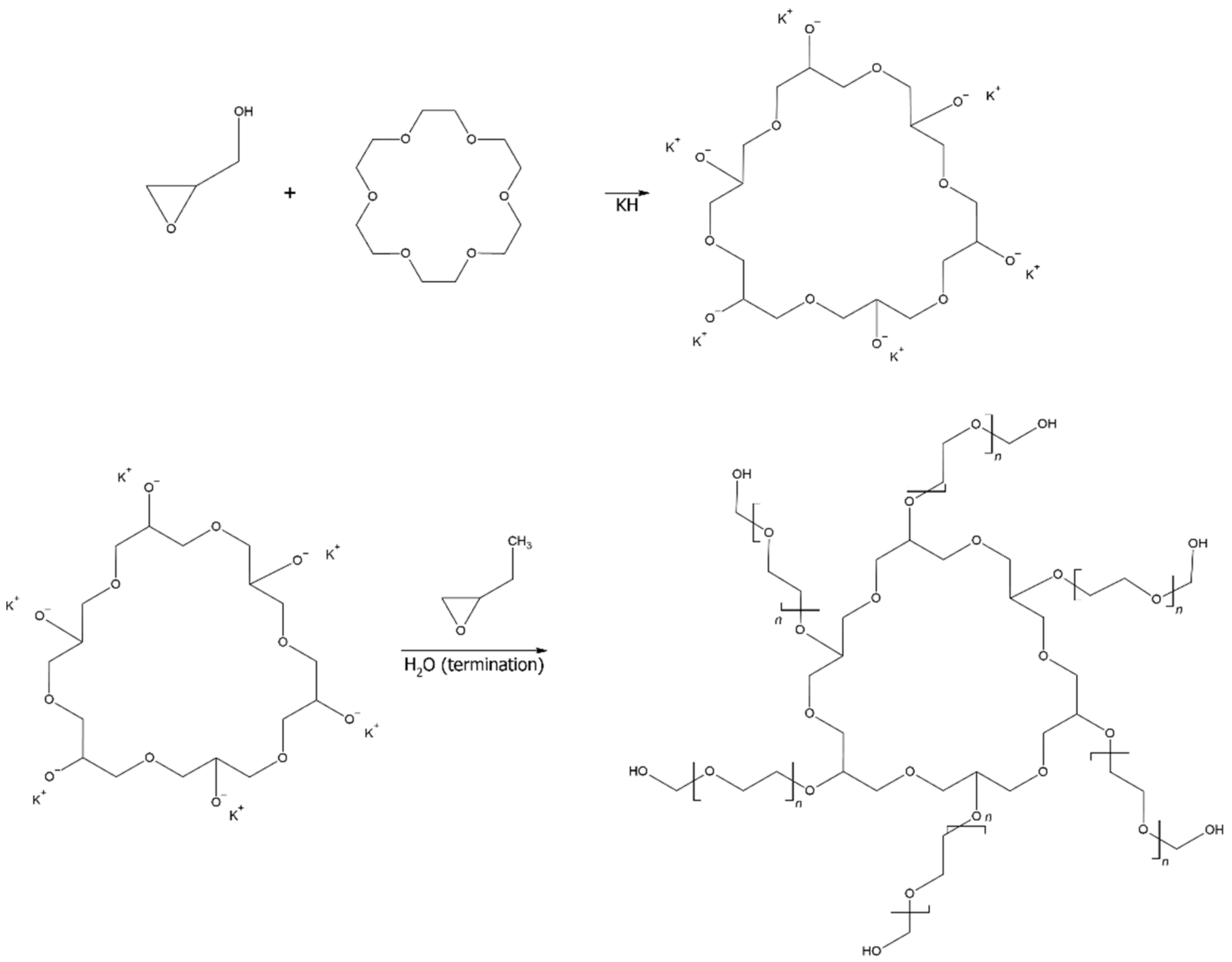
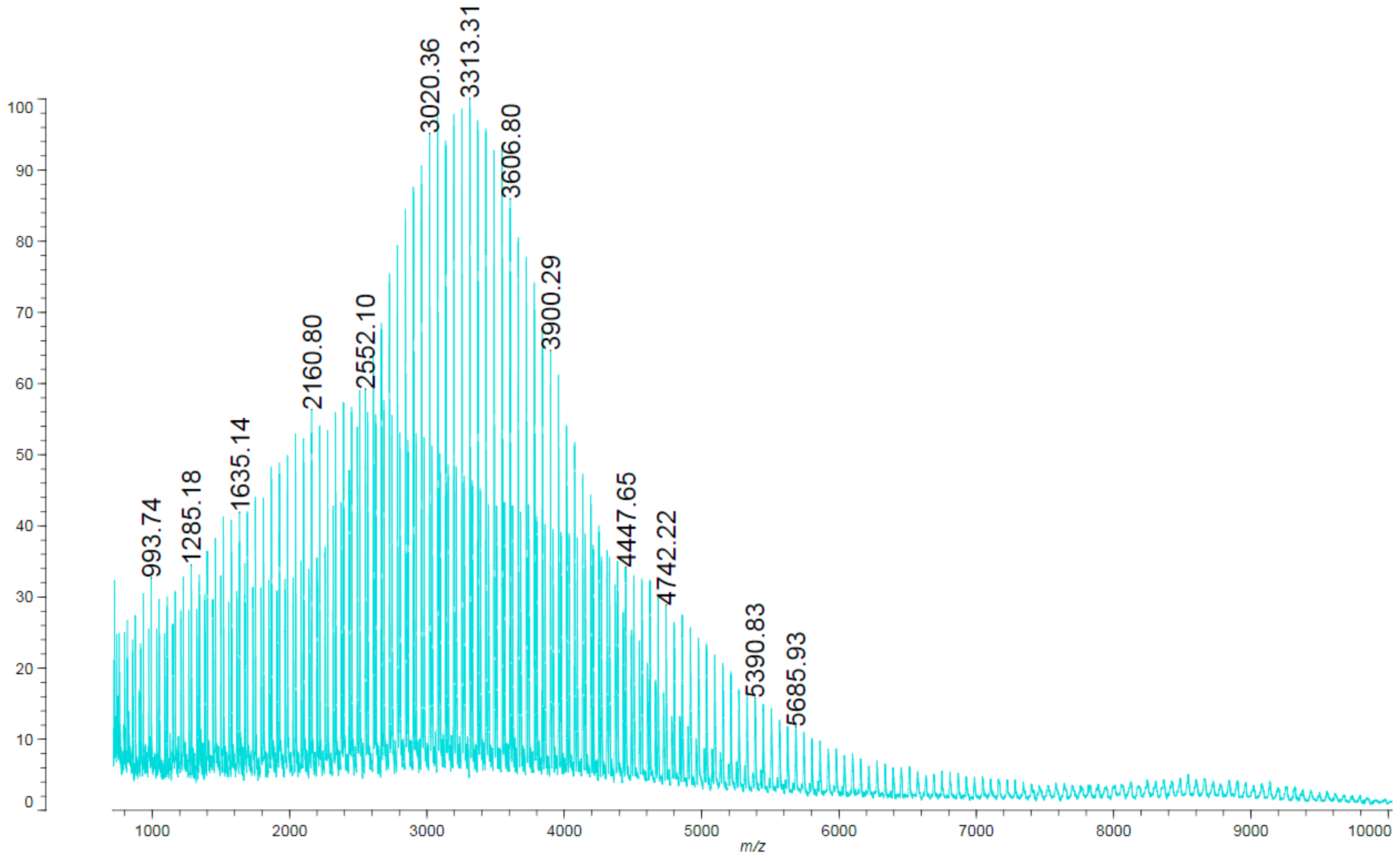
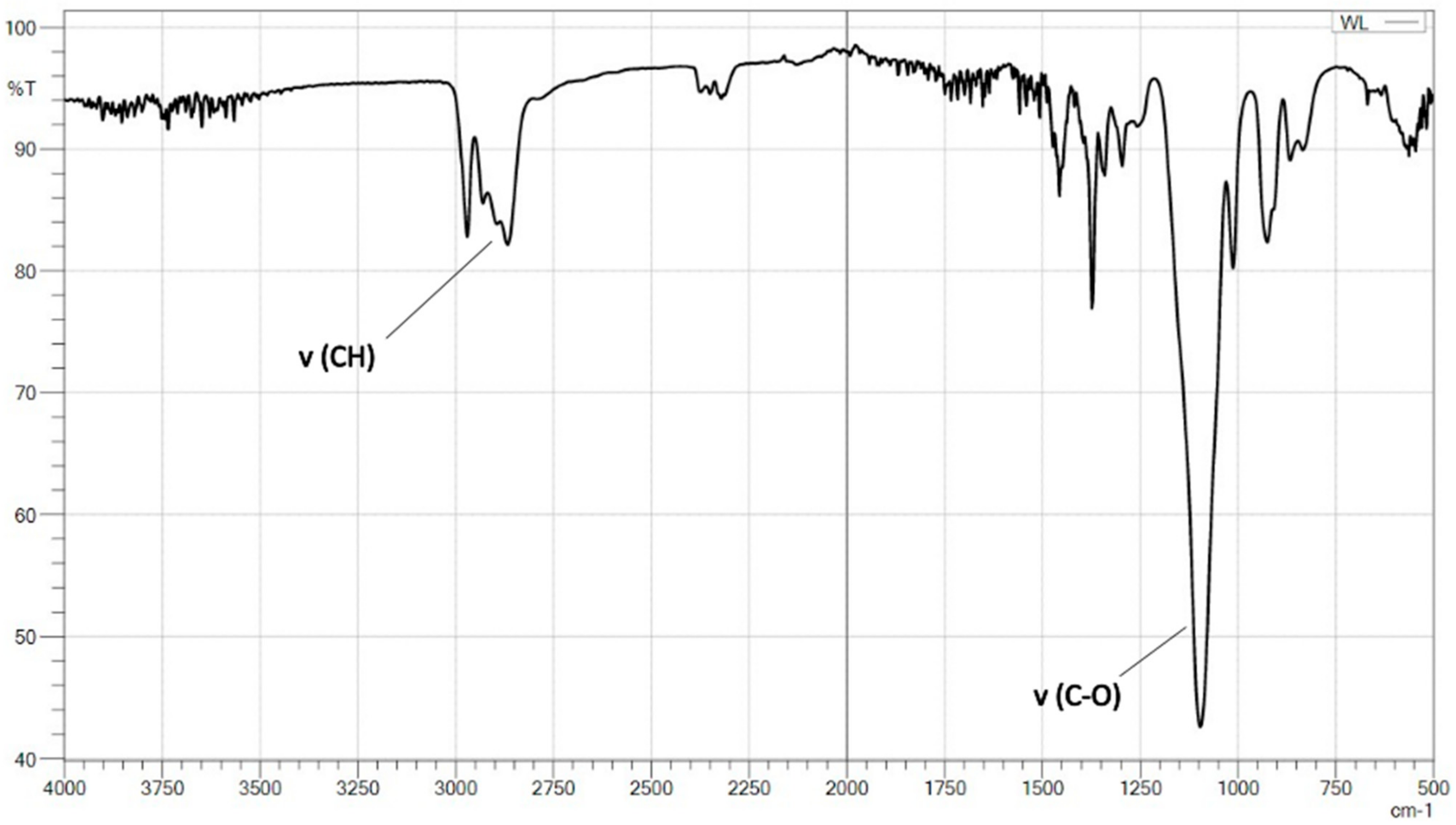
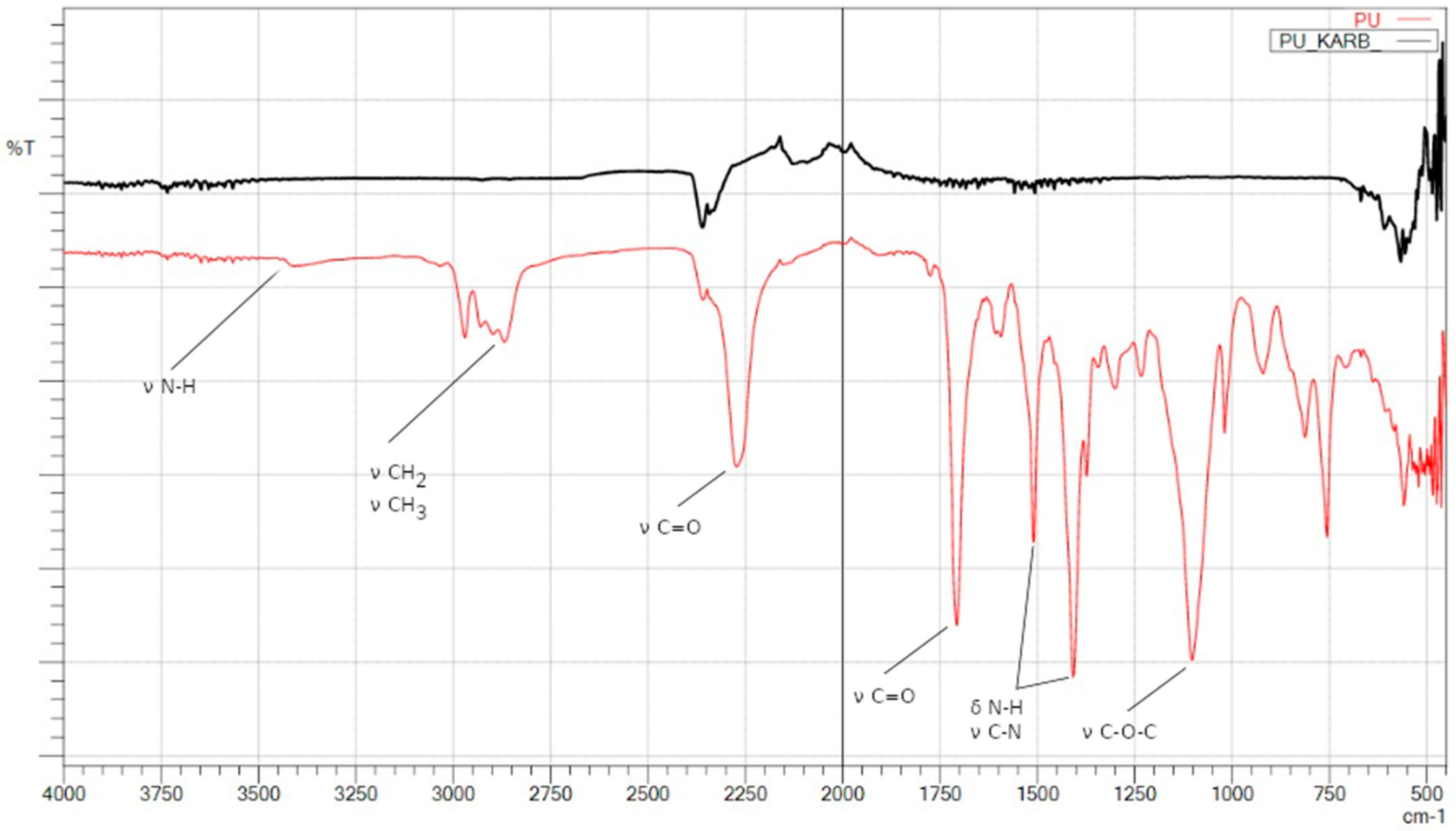
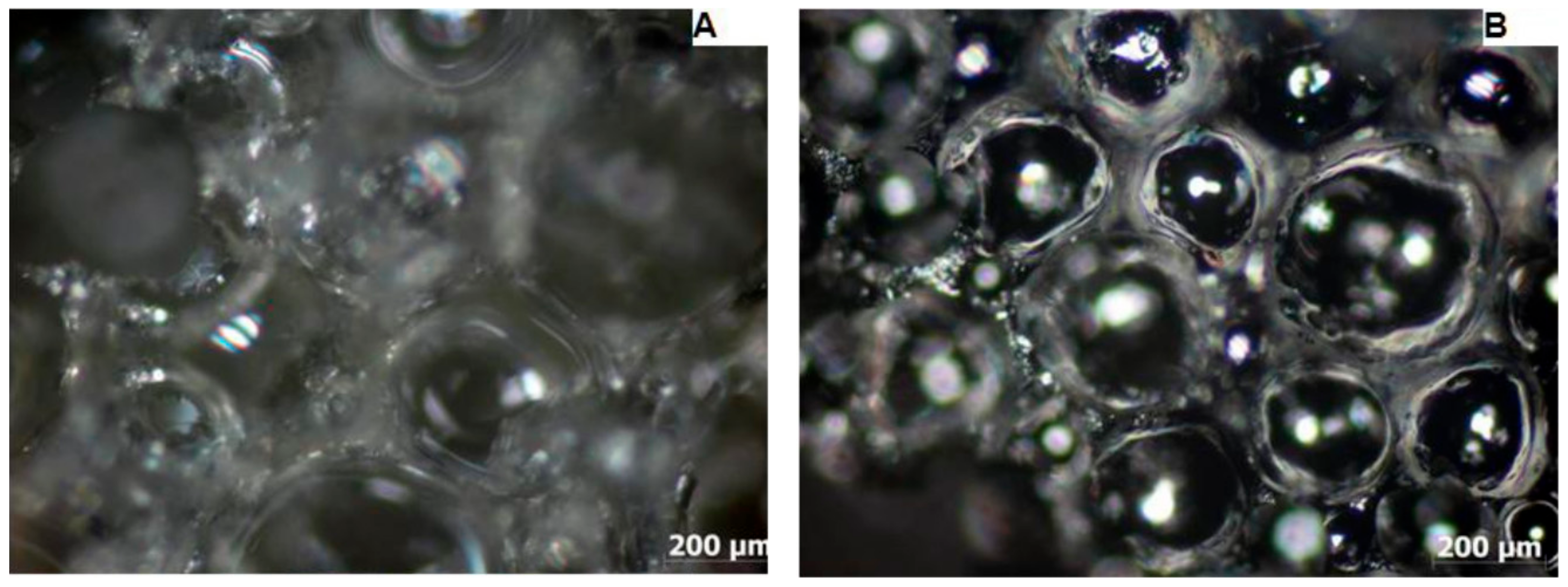
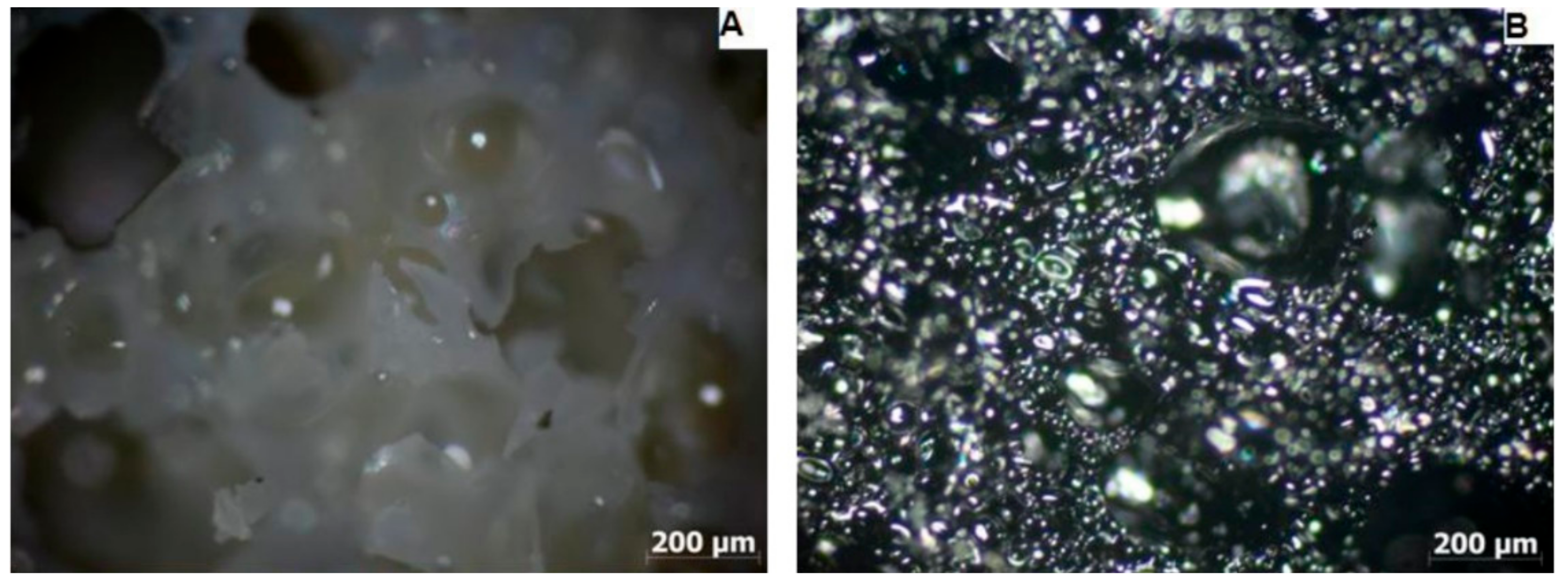
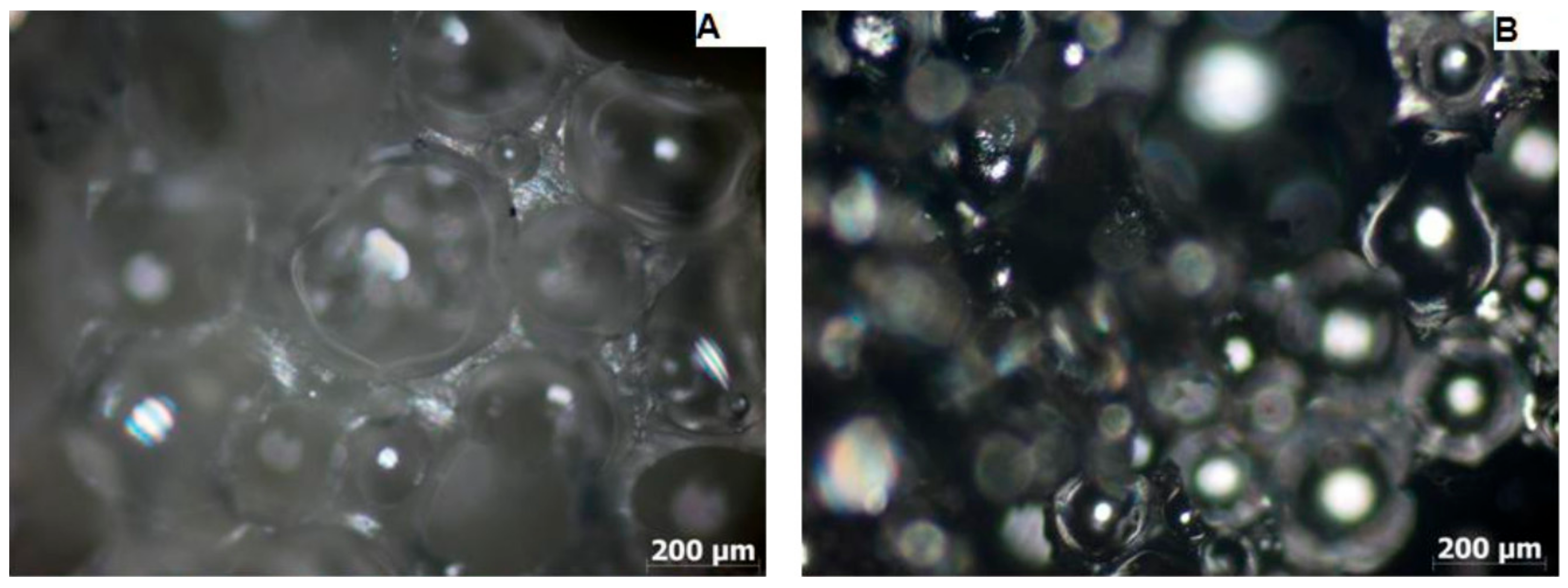
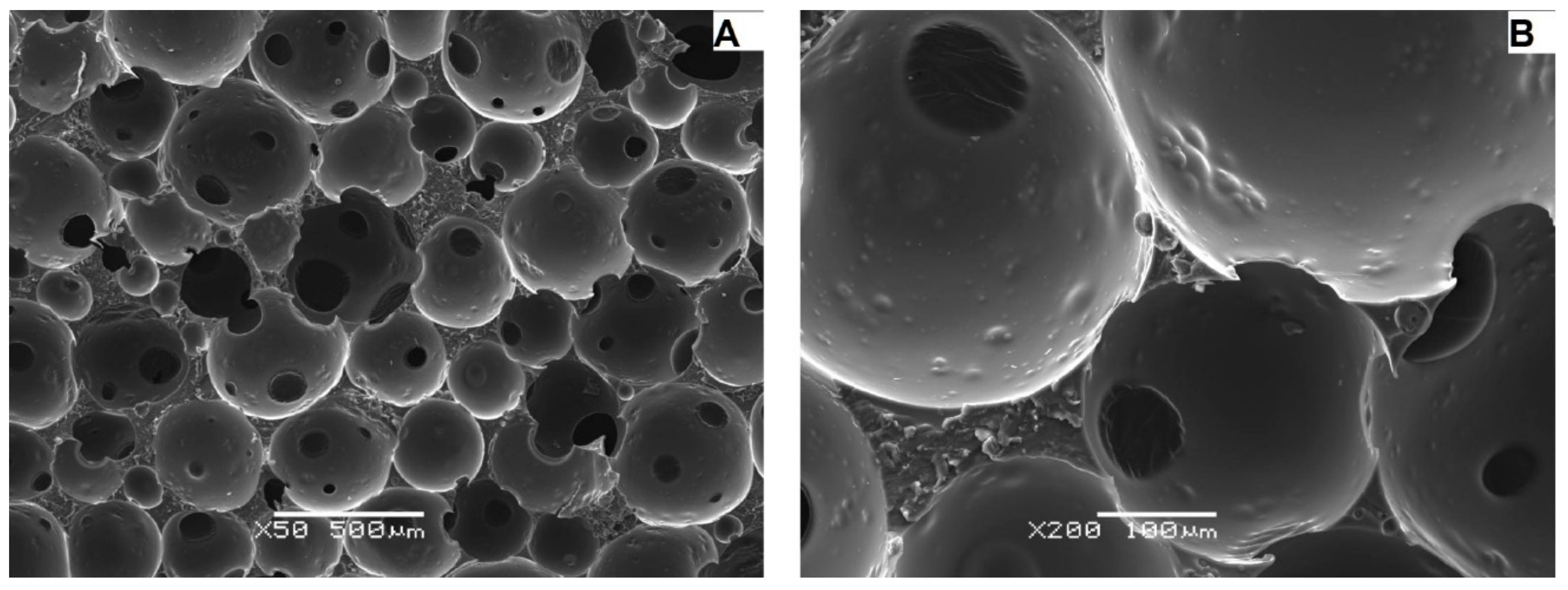

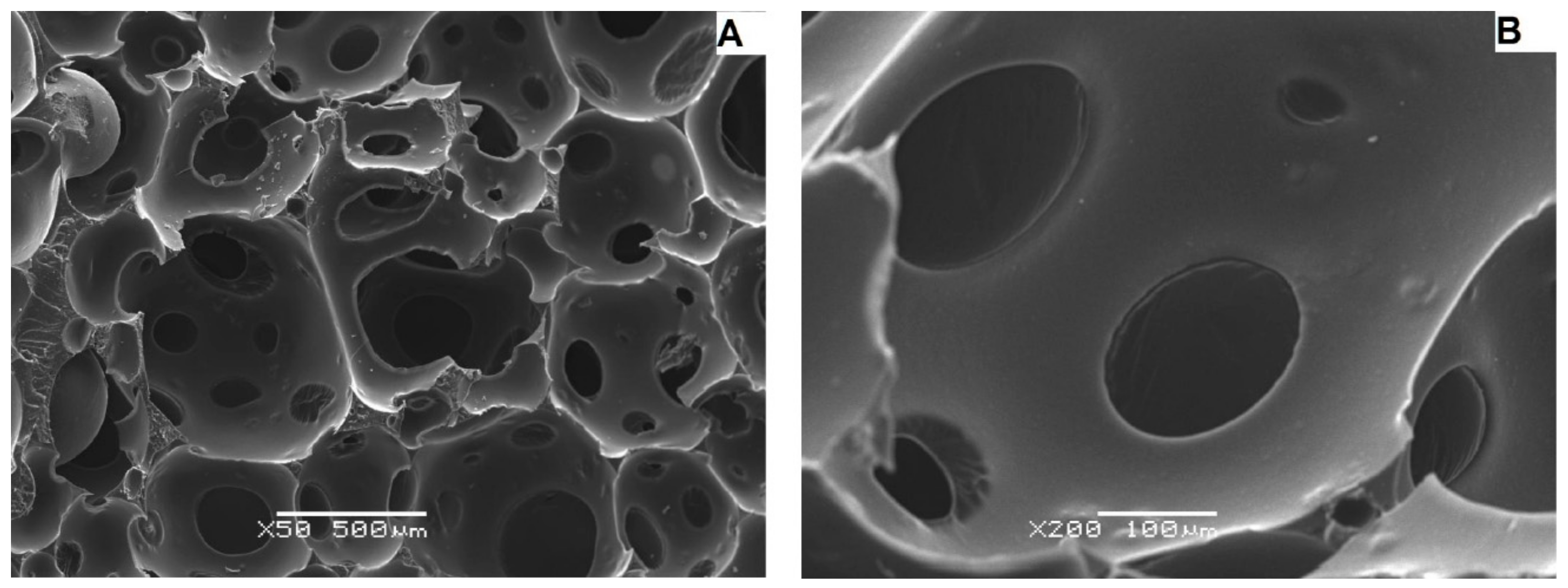
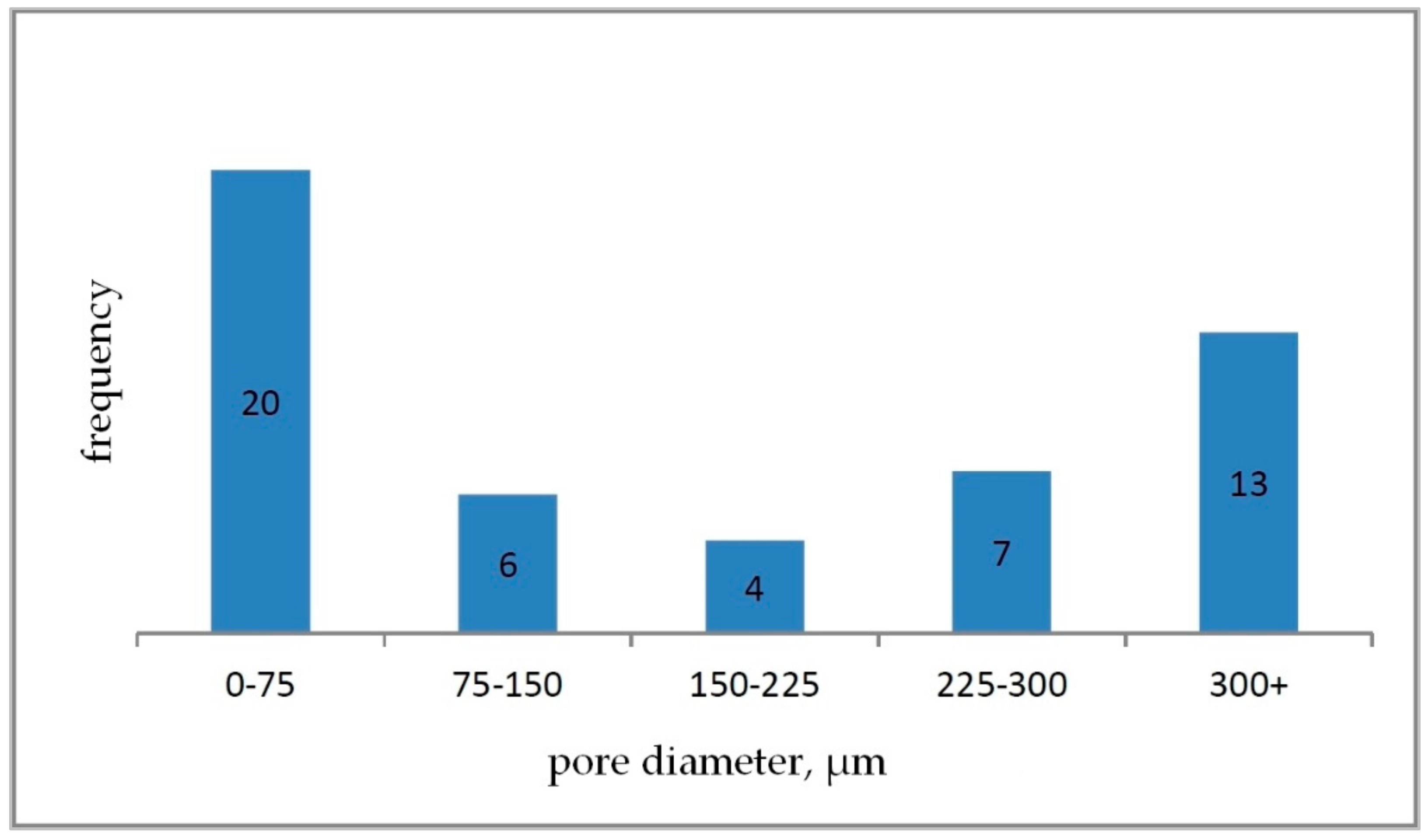


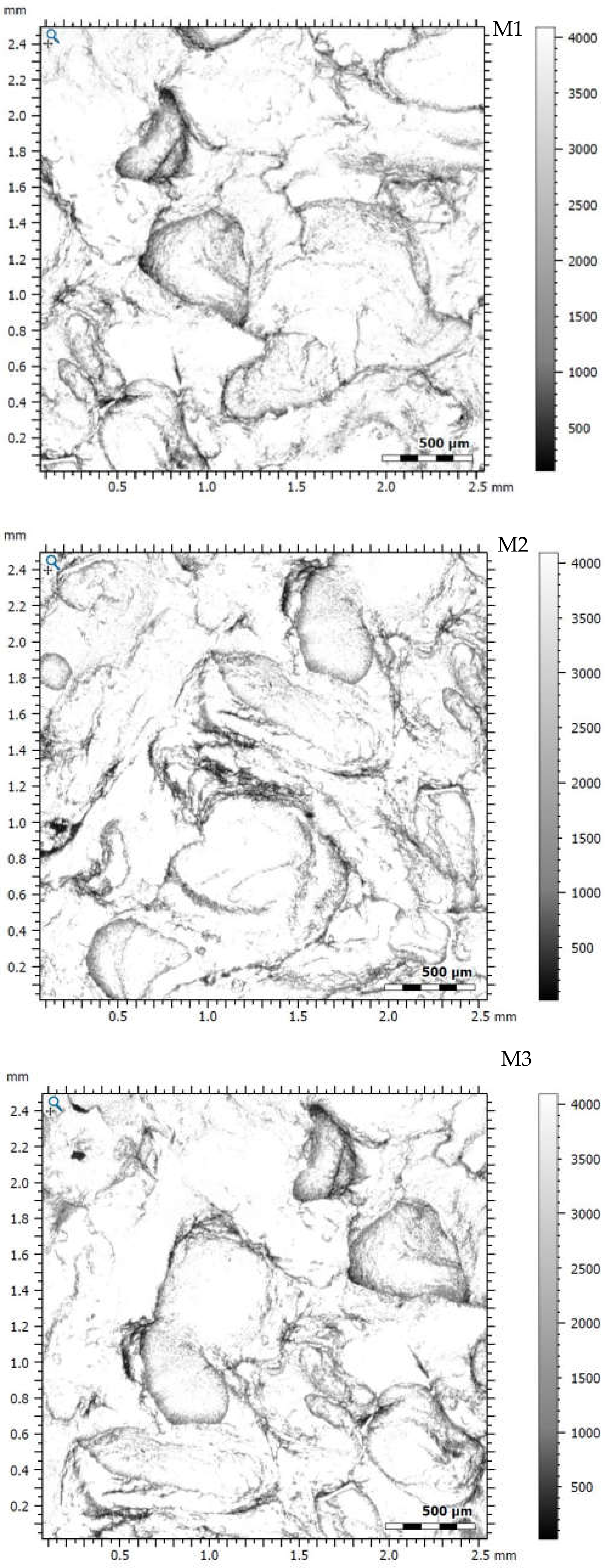
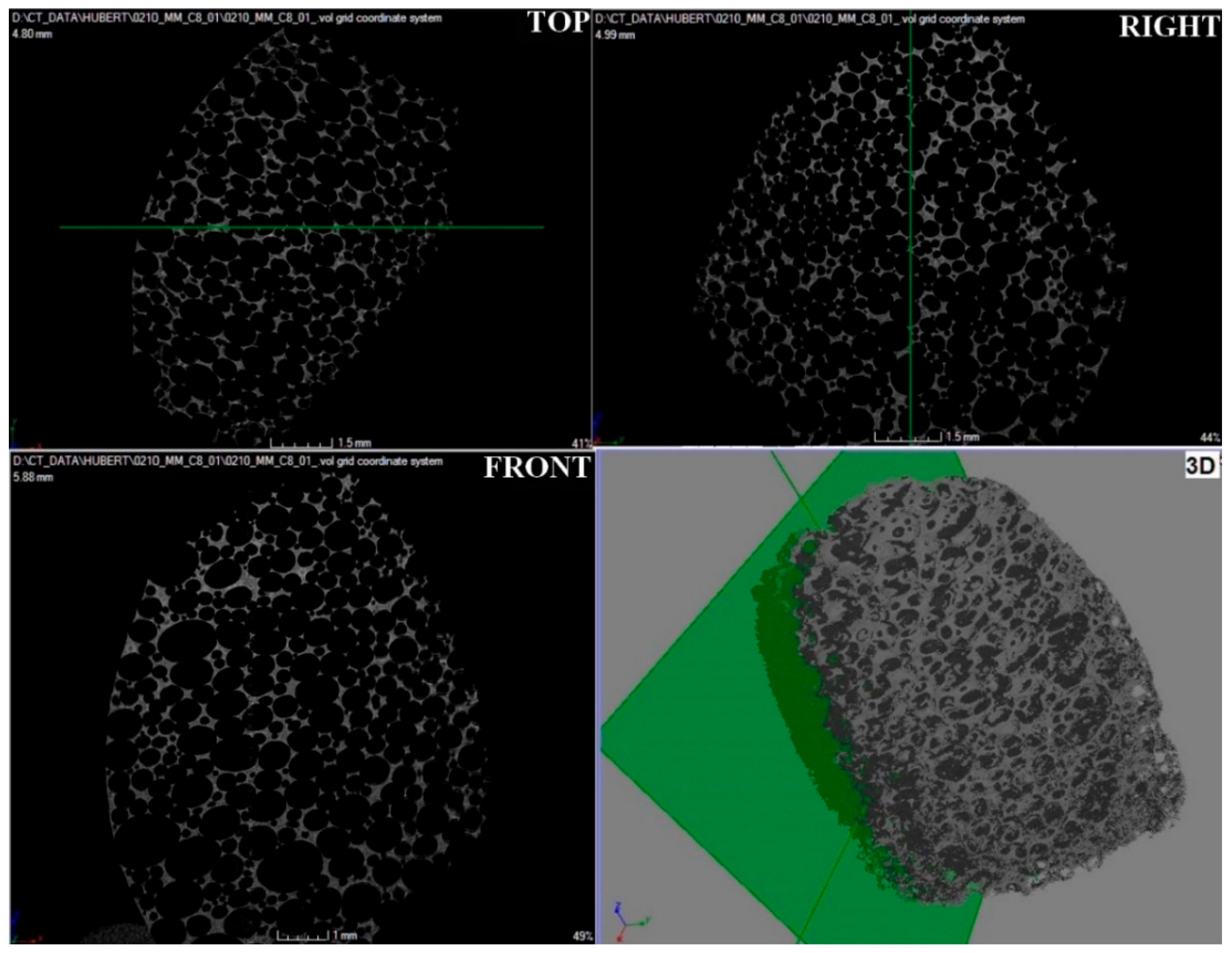

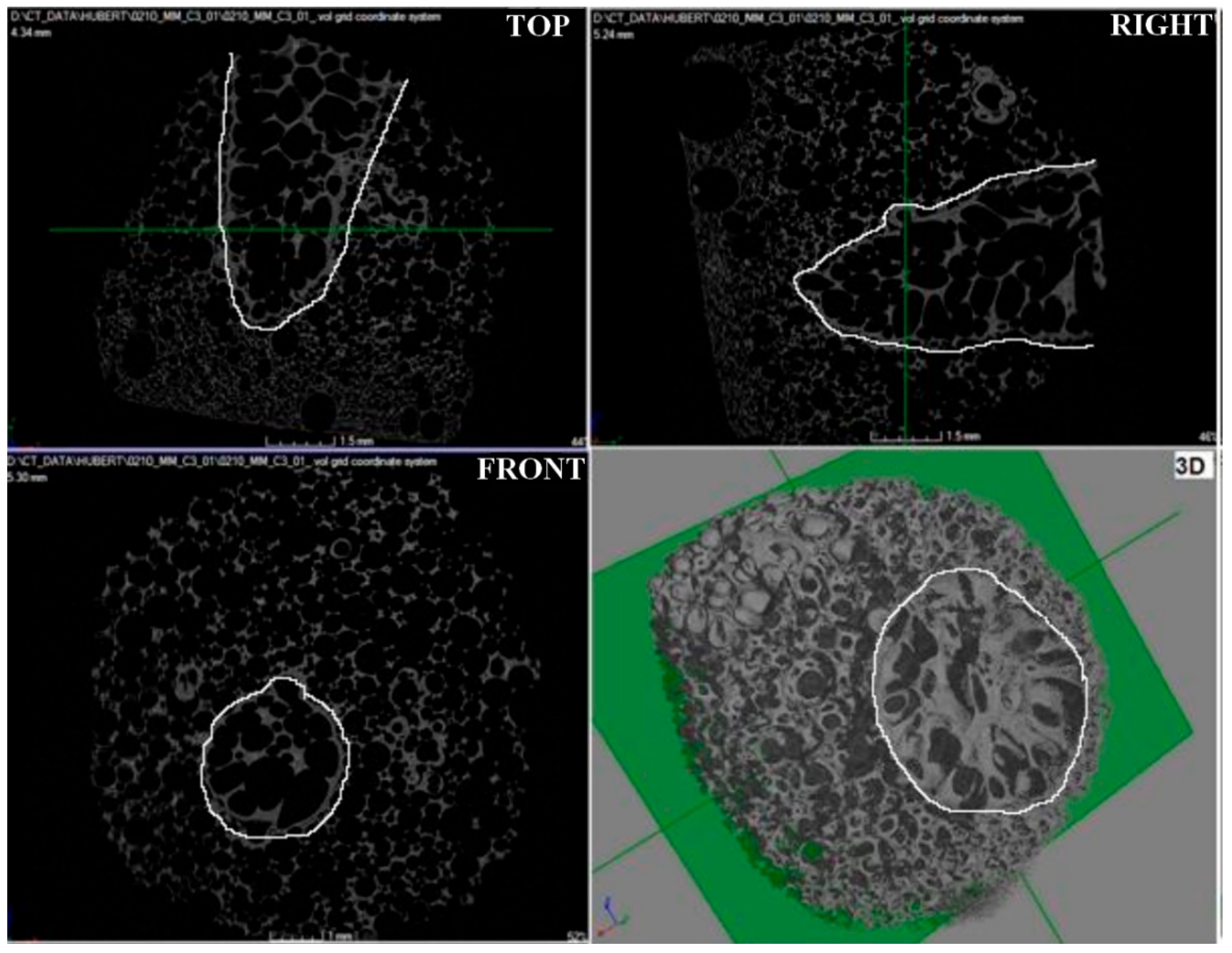

| Sample Name | Type of Polyol | Amount of Polyol (g) | Amount of Catalyst OH/NCO (mL) | Amount of PMDI (g) |
|---|---|---|---|---|
| M1 | Rokopol® D2002 | 200 | 200 μL | 200 |
| M2 | Star-shaped polyol | 100 | 600 μL | 100 |
| M3 | Rokopol® M 6000 | 100 | 600 μL | 100 |
| Voxel Size (μm3) | Number of Projections | Image Resolution (px) | Detector Type | Number of Photos to Average |
| 10 | 1000 | 2024 × 2024 | dxv–250 | 3 |
| Number of skips | Accelerating voltage (kV) | Glow current (μA) | Filters | Scan time (min) |
| 0 | 80 | 130 | none | 15 |
| No | M1 | M2 | M3 | |||||||||
|---|---|---|---|---|---|---|---|---|---|---|---|---|
| PUR Foam | Carbon Foam | PUR Foam | Carbon Foam | PUR Foam | Carbon Foam | |||||||
| Pore Surface Area (μm2) | Diameter (μm) | Pore Surface Area (μm2) | Diameter (μm) | Pore Surface Area (μm2) | Diameter (μm) | Pore Surface Area (μm2) | Diameter (μm) | Pore Surface Area (μm2) | Diameter (μm) | Pore Surface Area (μm2) | Diameter (μm) | |
| 1 | 97,520.46 | 352.37 | 59,990.33 | 276.37 | 2711.01 | 58.75 | 83,763.85 | 326.58 | 13,233.89 | 129.81 | 273,639.52 | 590.26 |
| 2 | 107,186.59 | 369.42 | 38,510.23 | 221.43 | 89,490.59 | 337.55 | 1606.32 | 45.22 | 180,199.34 | 479.00 | 5194.92 | 81.33 |
| 3 | 62,189.51 | 281.39 | 115,047.05 | 382.73 | 10,404.92 | 115.10 | 17,207.80 | 148.02 | 20,029.96 | 159.70 | 6179.65 | 88.70 |
| 4 | 157,711.91 | 448.11 | 28,889.18 | 191.79 | 33,899.83 | 207.76 | 2353.18 | 54.74 | 16,983.02 | 147.05 | 4642.09 | 76.88 |
| 5 | 196,493.51 | 500.18 | 42,015.50 | 231.29 | 55,088.03 | 264.84 | 731.61 | 30.52 | 90,579.10 | 339.60 | 1109.46 | 37.58 |
| 6 | 249,530.92 | 563.66 | 46,254.14 | 242.68 | 1010.09 | 35.86 | 2973.95 | 61.53 | 67,983.82 | 294.21 | 21,120.36 | 163.99 |
| 7 | 45,102.33 | 239.64 | 13,096.91 | 129.13 | 541.63 | 26.26 | 350.49 | 21.12 | 23,610.93 | 173.39 | 1993.17 | 50.38 |
| 8 | 102,286.87 | 360.88 | 5577.95 | 84.27 | 3495.81 | 66.72 | 6605.57 | 91.71 | 21,350.88 | 164.88 | 20,057.73 | 159.81 |
| 9 | 487,505.34 | 787.85 | 100,703.15 | 358.08 | 6724.97 | 92.53 | 5380.37 | 82.77 | 34,864.18 | 210.69 | 13,464.69 | 130.93 |
| 10 | 15,550.58 | 140.71 | 14,526.76 | 136.00 | 53,163.67 | 260.17 | 1228.88 | 39.56 | 33,329.07 | 206.00 | 14,091.31 | 133.95 |
| 11 | 18,946.79 | 155.32 | 1472.20 | 43.30 | 289,159.87 | 606.77 | 61,623.62 | 280.11 | ||||
| 12 | 7537.86 | 97.97 | 116.15 | 12.16 | 66,044.31 | 289.98 | 16,768.29 | 146.12 | ||||
| 13 | 16,868.42 | 146.55 | 2049.94 | 51.09 | 52,147.71 | 257.68 | 8777.39 | 105,72 | ||||
| 14 | 24,425.32 | 176.35 | 1963.34 | 50.00 | 637.37 | 90.07 | 14,638.55 | 136.52 | ||||
| 15 | 3934.86 | 70.78 | 250.68 | 17.87 | 142,769.16 | 426.36 | 42,258.55 | 231.96 | ||||
| 16 | 3080.29 | 62.63 | 3187.86 | 63.71 | 45,720.10 | 241.27 | 11,001.62 | 118.35 | ||||
| 17 | 1830.45 | 48.28 | 2394.84 | 55.22 | 96,958.92 | 351.36 | 34,567.34 | 209.79 | ||||
| 18 | 7884.70 | 100.20 | 283.77 | 19.01 | 23,223.00 | 171.95 | 16,142.48 | 143.36 | ||||
| 19 | 86,203.48 | 331.30 | 302.15 | 19.61 | 19,763.89 | 158.63 | 5681.30 | 85.05 | ||||
| 20 | 751.90 | 30.94 | 727.25 | 30.43 | 47,112.65 | 244.92 | 355,229.23 | 672.53 | ||||
| average | 152,107.80 | 404.42 | 46,461.12 | 225.38 | 21,399.73 | 134.29 | 6747.51 | 63.21 | 64,571.76 | 257.17 | 46,409.06 | 182.17 |
| Pore Number | Surface Area (μm2) | Diameter (μm) | Pore Number | Surface Area (μm2) | Diameter (μm) |
|---|---|---|---|---|---|
| 1 | 188,159.13 | 489.46 | 26 | 2316.12 | 54.30 |
| 2 | 189,020.76 | 490.58 | 27 | 7533.32 | 97.94 |
| 3 | 155,547.67 | 445.03 | 28 | 4268.62 | 73.72 |
| 4 | 62,543.17 | 282.19 | 29 | 363.62 | 21.52 |
| 5 | 49,444.83 | 250.91 | 30 | 1343.82 | 41.36 |
| 6 | 38,607.28 | 221.71 | 31 | 1122.49 | 37.80 |
| 7 | 68,376.95 | 295.06 | 32 | 33,477.04 | 206.46 |
| 8 | 141,951.33 | 425.13 | 33 | 1565.16 | 44.64 |
| 9 | 146,208.09 | 431.46 | 34 | 1122.49 | 37.80 |
| 10 | 133,671.00 | 412.55 | 35 | 1280.59 | 40.38 |
| 11 | 140,081.84 | 422.32 | 36 | 3387.23 | 65.67 |
| 12 | 173,416.59 | 469.89 | 37 | 6916.74 | 93.84 |
| 13 | 52,875.54 | 259.47 | 38 | 26,548.44 | 183.85 |
| 14 | 59,586.75 | 275.44 | 39 | 12,695.19 | 127.14 |
| 15 | 74,005.20 | 306.96 | 40 | 2628.36 | 57.85 |
| 16 | 103,197.81 | 362.49 | 41 | 332.00 | 20.56 |
| 17 | 119,853.33 | 390.64 | 42 | 316.19 | 20.06 |
| 18 | 112,138.19 | 377.86 | 43 | 3280.51 | 64.63 |
| 19 | 58,555.17 | 273.05 | 44 | 35,050.10 | 211.25 |
| 20 | 86,036.38 | 330.98 | 45 | 1154.11 | 38.33 |
| 21 | 41,737.60 | 230.53 | 46 | 5580.82 | 84.30 |
| 22 | 885.34 | 33.57 | 47 | 822.10 | 32.35 |
| 23 | 1912.97 | 49.35 | 48 | 7462.18 | 97.47 |
| 24 | 2766.70 | 59.35 | 49 | 525.67 | 25.87 |
| 25 | 8062.95 | 101.32 | 50 | 272.72 | 18.63 |
| average | 47,400.16 | 189.70 | |||
| Pore Number | Surface Area (μm2) | Diameter (μm) | Pore Number | Surface Area (μm2) | Diameter (μm) |
|---|---|---|---|---|---|
| 1 | 726.50 | 30.41 | 26 | 3210.50 | 63.94 |
| 2 | 822.75 | 32.37 | 27 | 1683.25 | 46.29 |
| 3 | 269.00 | 18.51 | 28 | 5267.25 | 81.89 |
| 4 | 4973.25 | 79.57 | 29 | 4089.25 | 72.16 |
| 5 | 1178.50 | 38.74 | 30 | 122.25 | 12.48 |
| 6 | 2961.25 | 61.40 | 31 | 16,031.00 | 142.87 |
| 7 | 753.00 | 30.96 | 32 | 536.00 | 26.12 |
| 8 | 193.75 | 15.71 | 33 | 1526.75 | 44.09 |
| 9 | 4261.75 | 73.66 | 34 | 34.25 | 6.60 |
| 10 | 876.50 | 33.41 | 35 | 2308.75 | 54.22 |
| 11 | 452.00 | 23.99 | 36 | 1422.75 | 42.56 |
| 12 | 1288.00 | 40.50 | 37 | 222.00 | 16.81 |
| 13 | 6999.50 | 94.40 | 38 | 7390.25 | 97.00 |
| 14 | 557.75 | 26.65 | 39 | 2002.25 | 50.49 |
| 15 | 11,460.50 | 120.80 | 40 | 5956.50 | 87.09 |
| 16 | 204.00 | 16.12 | 41 | 343.50 | 20.91 |
| 17 | 682.50 | 29.48 | 42 | 1660.25 | 45.98 |
| 18 | 479.00 | 24.70 | 43 | 3145.75 | 63.29 |
| 19 | 108.50 | 11.75 | 44 | 302.75 | 19.63 |
| 20 | 429.50 | 23.38 | 45 | 765.75 | 31.22 |
| 21 | 928.50 | 34.38 | 46 | 1444.25 | 42.88 |
| 22 | 837.50 | 32.65 | 47 | 35.50 | 6.72 |
| 23 | 2809.00 | 59.80 | 48 | 161.00 | 14.32 |
| 24 | 834.25 | 32.59 | 49 | 4862.00 | 78.68 |
| 25 | 267.75 | 18.46 | 50 | 7259.00 | 96.14 |
| average | 2342.75 | 45.38 | |||
| Pore Number | Surface Area (μm2) | Diameter (μm) |
|---|---|---|
| 1 | 6753.24 | 92.73 |
| 2 | 50,240.99 | 252.92 |
| 3 | 5638.17 | 84.73 |
| 4 | 163,789.70 | 456.67 |
| 5 | 10,451.82 | 115.36 |
| 6 | 41,422.51 | 229.65 |
| 7 | 209,825.62 | 516.87 |
| 8 | 7114.46 | 95.18 |
| 9 | 19,592.26 | 157.94 |
| 10 | 5123.83 | 80.77 |
| 11 | 4177.59 | 72.93 |
| 12 | 7024.16 | 94.57 |
| 13 | 8480.82 | 103.91 |
| 14 | 101,962.19 | 360.31 |
| 15 | 37,107.50 | 217.36 |
| 16 | 452,997.34 | 759.46 |
| 17 | 7306.85 | 96.45 |
| 18 | 17,252.18 | 148.21 |
| 19 | 14,558.74 | 136.15 |
| 20 | 51,430.66 | 255.90 |
| 21 | 205,443.86 | 511.45 |
| 22 | 60,229.51 | 276.92 |
| 23 | 5504.68 | 83.72 |
| 24 | 1464.51 | 43.18 |
| 25 | 1417.40 | 42.48 |
| average | 59,852.42 | 211.43 |
| M1 | M2 | M3 | Average | ||
|---|---|---|---|---|---|
| Height parameters | |||||
| Skewness (Ssk) | −1.081 | −0.9343 | −1.078 | −1.0311 | |
| Root mean square height (Sq) | mm | 0.2426 | 0.2312 | 0.2562 | 0.2433 |
| Kurtosis (Sku) | 4.761 | 3.835 | 4.557 | 4.3843 | |
| Maximum peak height (Sp) | mm | 0.5818 | 0.7783 | 0.6111 | 0.6571 |
| Maximum pit height (Sv) | mm | 0.9096 | 0.8126 | 0.8921 | 0.8714 |
| Maximum height (Sz) | mm | 1.491 | 1.591 | 1.503 | 1.5283 |
| Arithmetic mean height (Sa) | mm | 0.1847 | 0.1808 | 0.1882 | 0.1846 |
| Functional parameters | |||||
| Areal material ratio (Smr) | % | 0.0000953 | 0.0001907 | 0.0001907 | 0.000159 |
| Inverse areal material ratio (Smc) | mm | 0.2592 | 0.2497 | 0.2647 | 0.2579 |
| Extreme peak height (Sxp) | mm | 0.7224 | 0.6618 | 0.7622 | 0.7155 |
| Spatial parameters | |||||
| Auto-correlation length (Sal) | mm | 0.2849 | 0.2398 | 0.2945 | 0.2731 |
| Texture-aspect ratio (Str) | 0.8517 | 0.6526 | 0.7773 | 0.7605 | |
| Texture direction (Std) | 153.8 | 147.8 | 159.5 | 153.7 | |
| Hybrid parameters | |||||
| Root mean square gradient (Sdq) | 7.897 | 7.833 | 8.823 | 8.1843 | |
| Developed interfacial area ratio (Sdr) | % | 193.6 | 222.5 | 214.0 | 210 |
| Functional parameters (volume) | |||||
| Material volume (Vm) | mm³/mm² | 0.007349 | 0.006012 | 0.01025 | 0.0079 |
| Void volume (Vv) | mm³/mm² | 0.2666 | 0.2557 | 0.2749 | 0.2657 |
| Peak material volume (Vmp) | mm³/mm² | 0.007349 | 0.006012 | 0.01025 | 0.0079 |
| Core material volume (Vmc) | mm³/mm² | 0.2010 | 0.2093 | 0.1989 | 0.2031 |
| Core void volume (Vvc) | mm³/mm² | 0.2262 | 0.2185 | 0.2274 | 0.224 |
| Pit void volume (Vvv) | mm³/mm² | 0.04036 | 0.0372 | 0.04756 | 0.0417 |
| Feature parameters | |||||
| Density of peaks (Spd) | 1/mm² | 1.835 | 3.363 | 2.446 | 2.548 |
| Arithmetic mean peak curvature (Spc) | 1/mm | 2699 | 4843 | 4007 | 3850 |
| Ten point height (S10z) | mm | 1.113 | 1.278 | 1.147 | 1.1793 |
| Five point peak height (S5p) | mm | 0.4345 | 0.5552 | 0.4348 | 0.4748 |
| Five point pit height (S5v) | mm | 0.6783 | 0.7230 | 0.7124 | 0.7046 |
| Mean dale area (Sda) | mm² | 0.1847 | 0.1106 | 0.1621 | 0.1525 |
| Mean dale volume (Sdv) | mm³ | 0.01834 | 0.003223 | 0.01043 | 0.0107 |
Publisher’s Note: MDPI stays neutral with regard to jurisdictional claims in published maps and institutional affiliations. |
© 2022 by the authors. Licensee MDPI, Basel, Switzerland. This article is an open access article distributed under the terms and conditions of the Creative Commons Attribution (CC BY) license (https://creativecommons.org/licenses/by/4.0/).
Share and Cite
Swinarew, A.S.; Flak, T.; Jarosińska, A.; Garczyk, Ż.; Gabor, J.; Skoczyński, S.; Brożek, G.; Paluch, J.; Popczyk, M.; Stanula, A.; et al. Polyurethane-Based Porous Carbons Suitable for Medical Application. Materials 2022, 15, 3313. https://doi.org/10.3390/ma15093313
Swinarew AS, Flak T, Jarosińska A, Garczyk Ż, Gabor J, Skoczyński S, Brożek G, Paluch J, Popczyk M, Stanula A, et al. Polyurethane-Based Porous Carbons Suitable for Medical Application. Materials. 2022; 15(9):3313. https://doi.org/10.3390/ma15093313
Chicago/Turabian StyleSwinarew, Andrzej S., Tomasz Flak, Agnieszka Jarosińska, Żaneta Garczyk, Jadwiga Gabor, Szymon Skoczyński, Grzegorz Brożek, Jarosław Paluch, Magdalena Popczyk, Arkadiusz Stanula, and et al. 2022. "Polyurethane-Based Porous Carbons Suitable for Medical Application" Materials 15, no. 9: 3313. https://doi.org/10.3390/ma15093313
APA StyleSwinarew, A. S., Flak, T., Jarosińska, A., Garczyk, Ż., Gabor, J., Skoczyński, S., Brożek, G., Paluch, J., Popczyk, M., Stanula, A., & Stach, S. (2022). Polyurethane-Based Porous Carbons Suitable for Medical Application. Materials, 15(9), 3313. https://doi.org/10.3390/ma15093313










